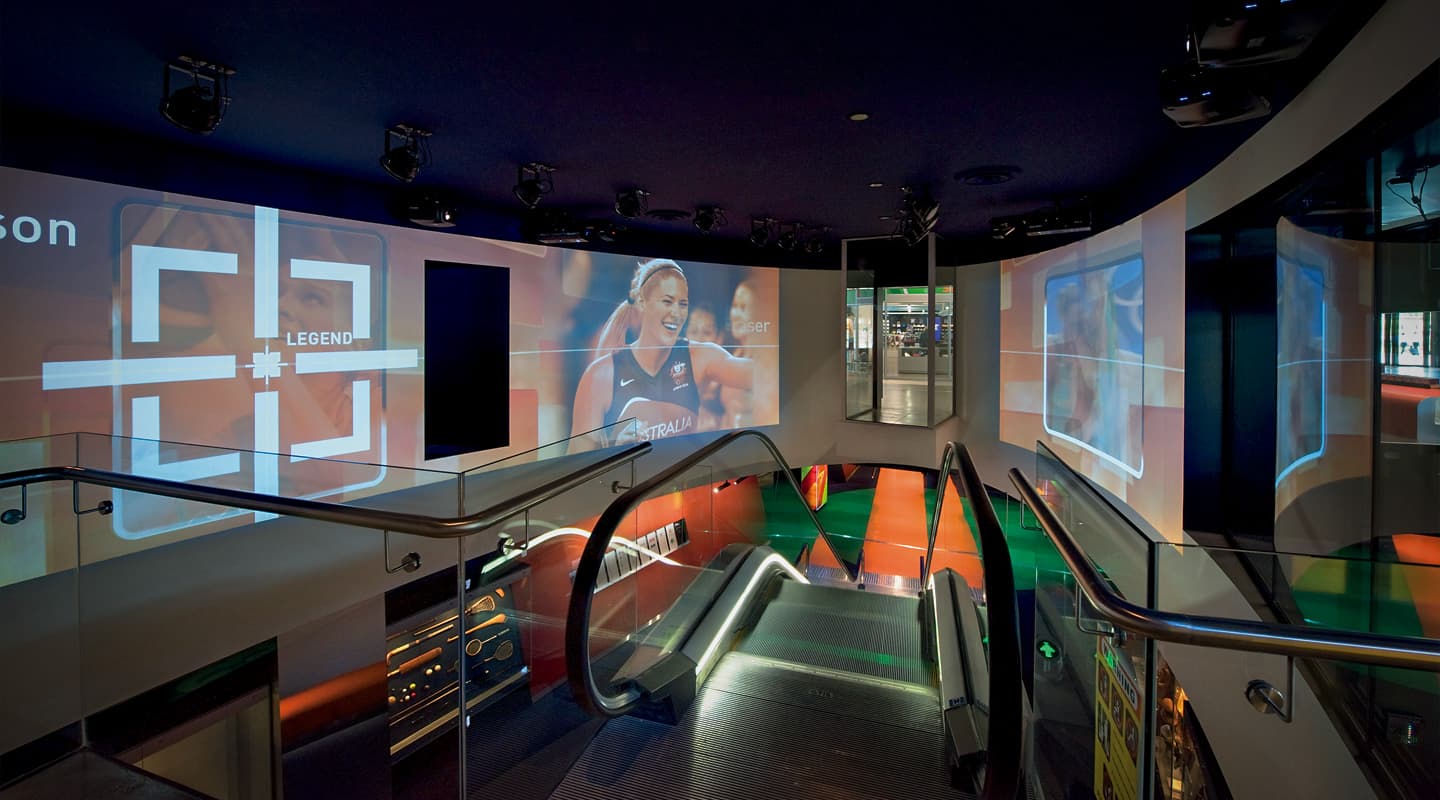
National Sports Museum
International sporting pilgrims have a new sacred site to add to their itinerary.
Text:/ Christopher Holder
Photos:/ John Gollings
If Sport is our nation’s true religion, then the MCG is Sport’s grandest cathedral. That being the case, somewhere in the presbytery… or in the left lower nave of the main transept… lurks Sport’s hi-tech multimedia shrine — the National Sports Museum.
The museum is a great way for sports nuts to while away a good couple of hours. The interactive displays package some fantastic footage and other freshly-authored productions. Big screens, small screens, projectors, touchpanels, stump cams, combined screens, moving lights, theatrettes, flat panel directional speakers… and even the occasional sighting of a Pepper’s Ghost [more later]; it’s all packed into this ‘content rich’ funhouse.
Mental Media was the AV consultant on the job, headed up by the very able Bruce Brown. Mental Media are museum specialists [see last issue for more on their work at the Australian War Memorial] and have considerable experience in not only spec’ing the hardware but authoring the creative elements. Possibly even more crucial, Mental Media knows a thing or two about tip-toeing through the minefield of committees, trustees and ‘other stakeholders’.
I met Bruce and the museum’s AV technician James Power in the air-conditioned whir of the facility’s machine room.
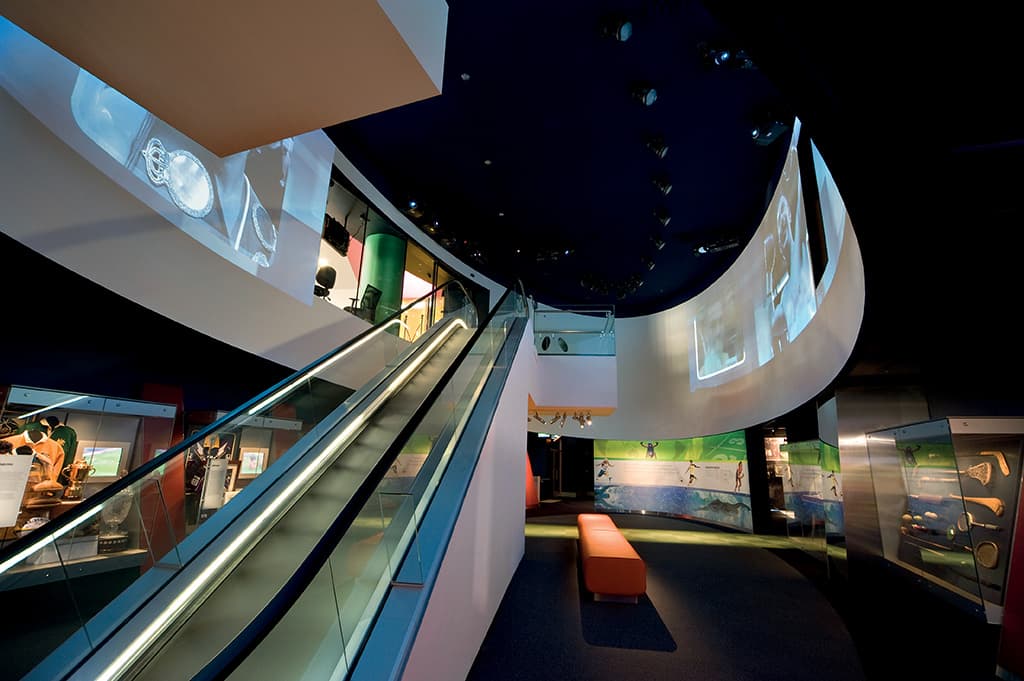
‘Our Sporting Culture’ greets visitors in the museum’s atrium. Four Projectiondesign F30s project onto the curved ‘Elipse’ wall. The content was produced in Watchout while a Bose Freespace 3 sound system delivers the audio.

TRIBAL WARS – AUSTRALIA’S GAME
Bruce Brown: Tribal Wars uses three Projectiondesign F30s. In this case, because the design of the space was altered, we had to put in wide angle 1-to-1 lenses to hit our target and to keep the projectors out of reach of the punters. So these are fixed-length lenses, which James and I have very precisely lined up. We’re not using the geometry at all, this is traditional projection alignment, but again it’s a Watchout production: a moving image stuck onto a mask, stuck onto a background – layer upon layer.
Each of the projectors is 1400 by 1024 so we’re talking about more than 3000 pixels in width. So it is a high quality image. There’s nothing special about the screen, it’s just MDF painted matte white. The Projectiondesign contrast levels are good. They’re a really great projector to work with from a technical point of view and a visual point of view – a really nice looking image. And, of course, it depends on the material. We produce it to the pixel level – the ‘brick wall’ is 3000 pixels wide, and it’s been produced to the actual pixel.
We’re using Chief mounts on all the projectors, which are a quick release mount and offer very precise adjustments. In most cases, because of the air-conditioning and everything else on the ceiling, we’ve had to come down on hook or rod droppers and run in uni-strut and then attach the projector mounts to the uni-strut.
THE G WHIZ
AV: Given the museum is effectively a vast collection of AV devices, is it too much to hope that you were called in early on in the piece?
Bruce Brown: I’m pleased to say, we were. Getting the multimedia consultant involved in those early stages makes everything more achievable and allows you to be more ambitious. We started working when the museum was a bare concrete shell. There were allowances made in the initial budgets to boost up or move air-conditioning ducts that were impinging on the space, and we were able to lay in all of our cabling, our power and data distribution before the exhibitions went in. So we were way ahead of the game.
AV: And were you given much creative freedom?
Bruce Brown: We were given the opportunity to to work with CMD, the exhibition designers, to conceptualise the productions – what they should look like, and how they should fulfil the objectives. That doesn’t often happen to a multimedia production company, and in most cases the technical design and multimedia production are separate. We have expertise in both spheres, so we’re fortunate that we could go in at that base level and say, “we think it should look like this; this is the creative concept and this is how you do it technically.” That’s a big leap from [the normal scenario of] someone going in and doing the creative consultancy part of it first, followed by the technical consultant tearing his hair out and being forced to make technical compromises.
CLUB SONG
We have a 16 by 9 touchscreen running Adobe Air which goes back to the control room and talks to the Medialon control system. The Medialon control system then says, ‘play this track’, and up in the roof we have a Projectiondesign F30, which projects the lyrics onto the central ‘table’ below and plays the club song… in effect, it’s karaoke.
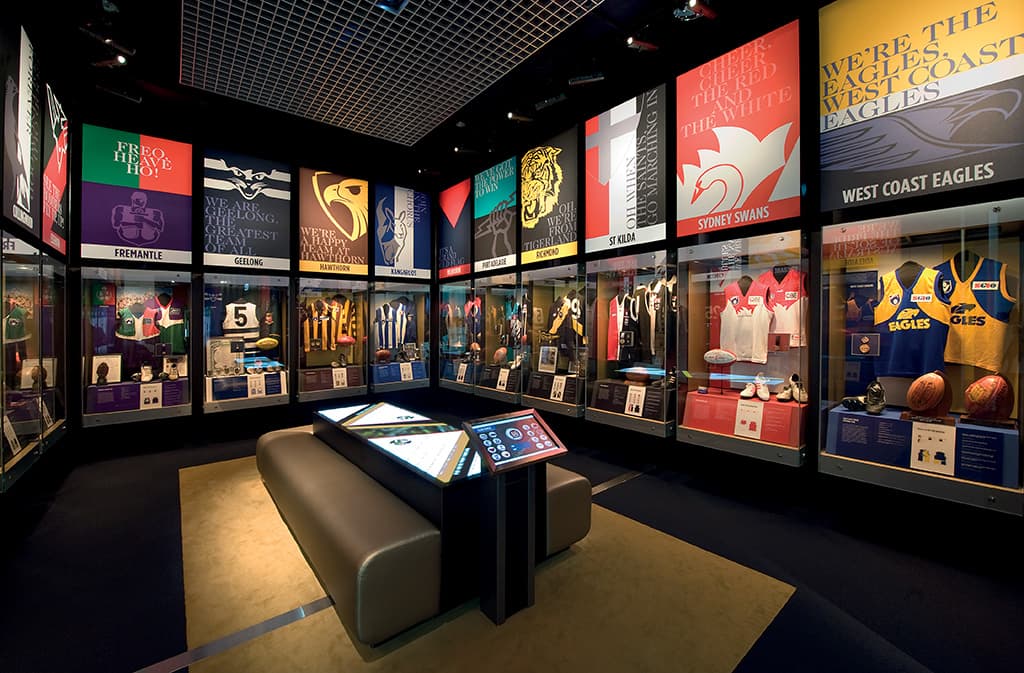
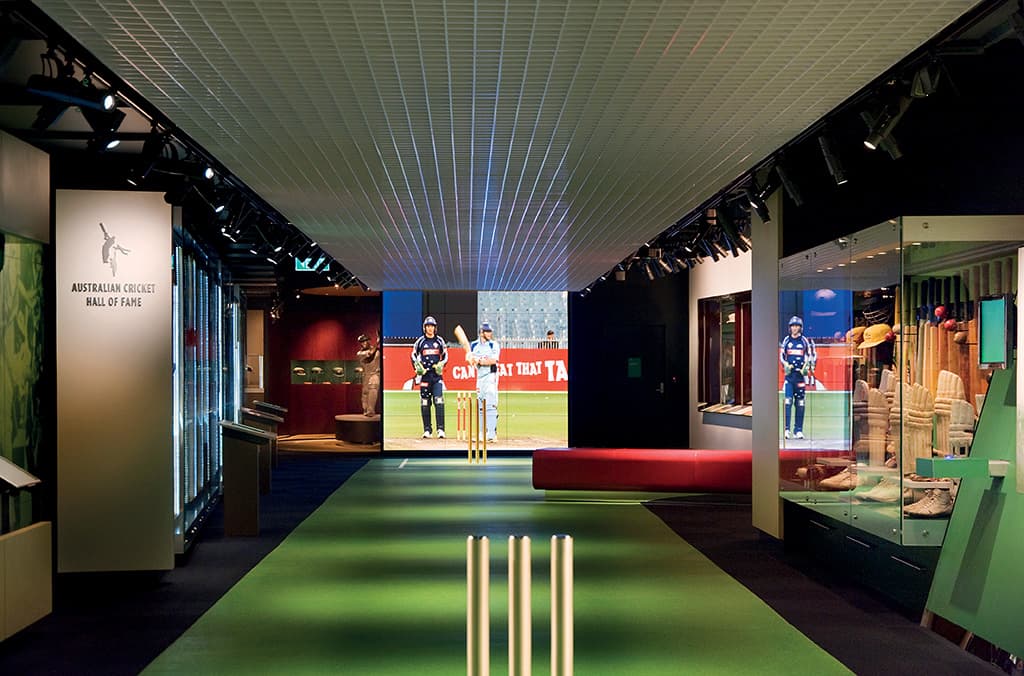
‘Backyard to Baggy Green’ is a treasure trove of cricket artefacts and archival footage. The ‘gladiator screen’ is an example of an MPDP multi-screen from Total Concept Projects. The footage is shot in HD – a State Twenty20 match – and provides people with an insight into the game.
THIS SPORTING LIFE
AV: Bruce, can you take me through an example of how one of the museum’s productions works?
Bruce Brown: As an example, take the production in the ellipse as you enter, Our Sporting Culture [pictured above]. The display was produced in Watchout. The show sits on four computers which are routed through a KVM for monitoring. They also go out to DVI baluns then over Cat6 to DVI baluns in the roof next to four Projectiondesign F30s in the atrium. The projectors are also networked for powering on and off via the Medialon control system. Multi-channel audio is also part of the production which go out to Bose FreeSpace speakers via Dynacord 1415 multi-channel amplifiers in the machine room.
AV: And is the geometry of the image in the eliptical atrium done by the projector or in software?
Bruce Brown: In software. The beauty of the Watchout system is you can have an uneven surface and ajust the geometry any way you like. For example, there’s window in the atrium, so we impose a blank onto the image to ensure we’re not projecting through the window.
AV: And why the banks of DVD players in the machine room?
Bruce Brown: We have a good number of displays with looping footage and audio. Take for example, Cathy Freeman’s display with her jumpsuit, etc. There’s a screen showing the race which is coming from a Pioneer DVD-V8000 player. The composite video comes out of the DVD players, and goes into a Quest RX8 eight-channel balun, and goes out via Cat6. The beauty of this system is we can monitor any one of these channels. The control system can chose any one of the channels from the RX8 and look at it as a composite signal to monitor the output.
It means that James here can constantly monitor the system.
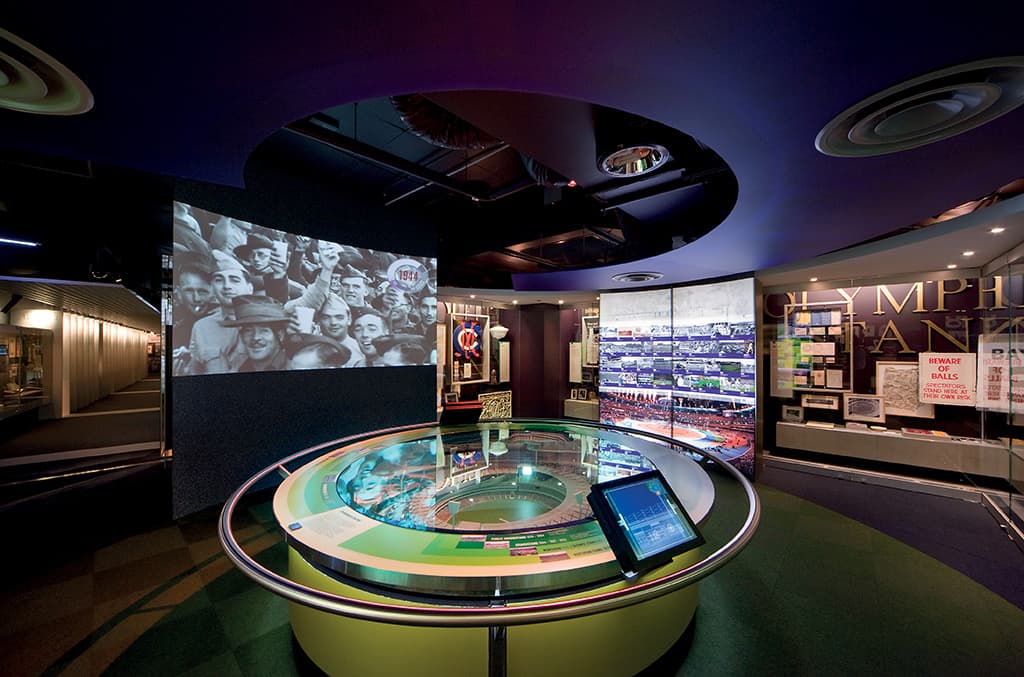
‘The People’s Ground’ takes visitors on a multimedia journey through the history of the MCG.
SPECTRE OF WARNIE
Two Pepper’s Ghosts are featured at the Australian Sports Museum. One featuring Shane Warne and the other James Hird, both discussing their careers.
The presentation is based on three Projectiondesign F30s that rear project onto a screen that sits above the audience’s head. Between the audience and the ‘set’ is an angled sheet of glass and the ‘ghost’ of Warnie is a reflection of the rear projection screen.
The technology behind the effect isn’t hugely sophisticated, but there’s a lot of skill in getting the illusion of depth spot on. If Warnie starts floating above the set’s floor or disappearing behind props then the illusion is shot. Bruce states: “this technique is used badly in more locations than it is used well. This is a pretty good example.” The Shirley Spectra is responsible for the two at the Museum as well as a rather natty one at Sovereign Hill (amongst others).
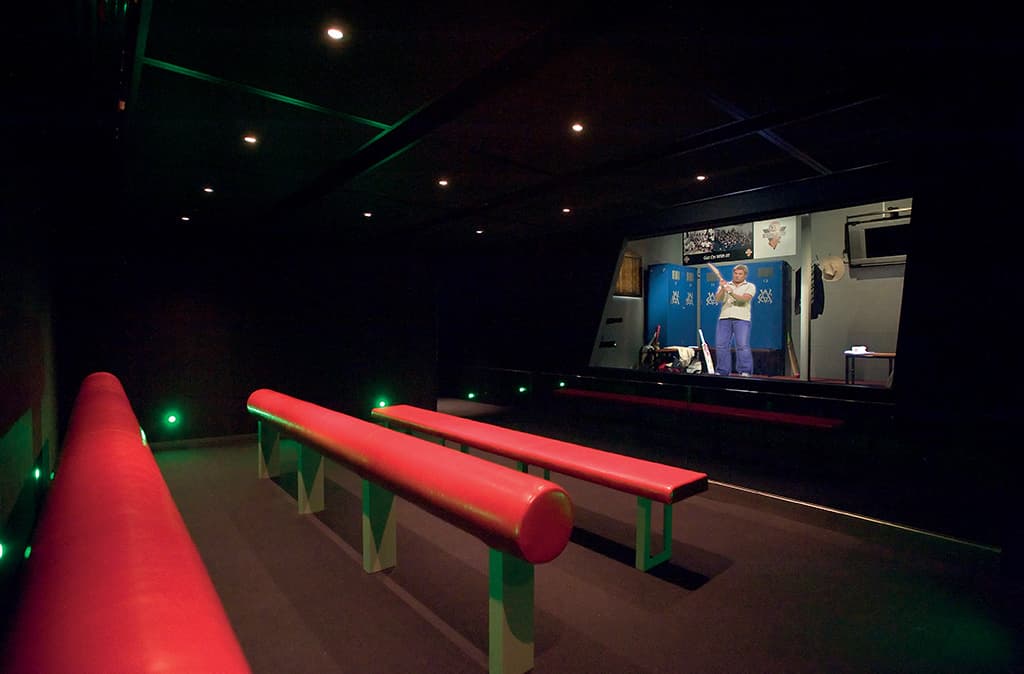
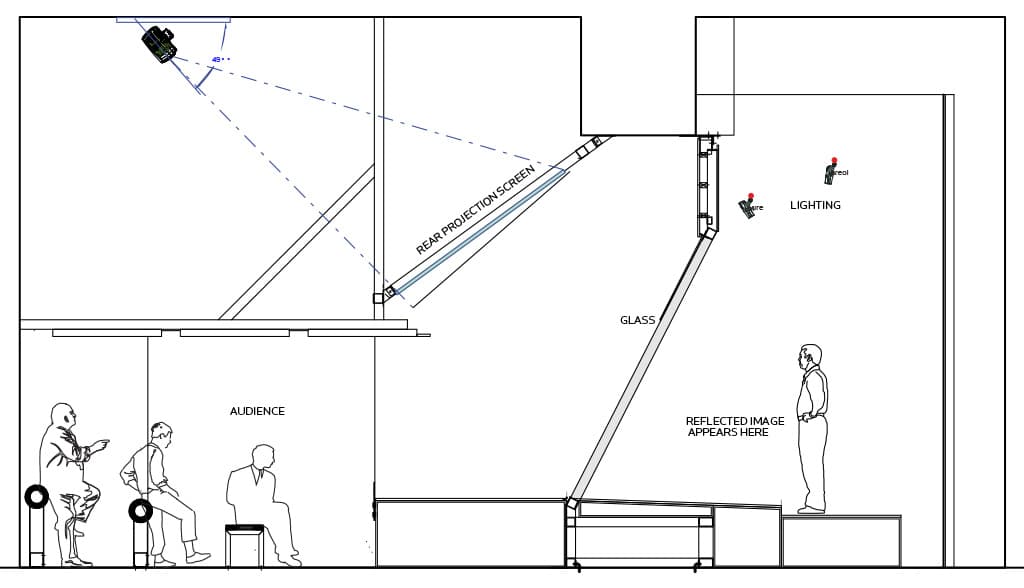
FOCUSSED AUDIO
Bruce Brown: We have a number of Dakota Audio [FA 602 FH] directional audio panels. If you’re in a normal museum environment and you have three different exhibits with three different speakers all within four metres of each other, it’d be a complete mess – you need to concentrate the audio and these panels allow us to do that. So long as you have a bit of soft covering on the floor (to prevent unwanted reflections), it produces a defined hotspot of sound that no one else in the room hears.
We also use a Hypersonic product. It’s different to the Dakota Audio flat panels in that it has a very limited dynamic range. As you can hear, it’s quite squeaky. It’s only really suitable for voice, but the directionality is quite amazing.
AV: Why DVD players and not from hard disk?
Bruce Brown: Because DVD players are tried and tested. There are many places where they’re being used and have been used very successfully for a very long period of time. The beauty of a DVD player is if one breaks down it’s very simple to pull out the data ie. the disc; put it in a new DVD player, re-plug, turn it on and it’ll work immediately. If you have a spare one in the rack, you can change one in a couple of minutes.
Places like the Australian War Memorial use Pioneer 7300s that have been in service ever since they were first released. Admittedly, they’ve had some motors replaced, but nevertheless, they’ve still got 7300 DVDs in there. The V8000 is a new version of the same thing.
Also you tend to pay more for a solid-state machine that gives you the same resolution. Some people might say the DVD player is old fashioned because it’s still got moving parts, and in five years time it may well be old fashioned, but at the moment I think it’s still the best value for money solution.
AV: The machine room’s climate control seems pretty ‘agressive’ [he says, yelling over the dull roar of the air conditioner].
Bruce Brown: Yes, the air conditioning is running full tilt – start overheating a room like this you’re asking for trouble.
Recently, I was talking to an air conditioning engineer and was told: “whoa, that’s as much air conditioning as you’d use in a full-blown computer room!” Actually yes! In fact, we have more, because not only do we have computers we have amplifiers that are pumping out heat. Most of the people involved in general engineering have no idea what we do and it’s a constant battle to get them to understand. And that includes project managers, builders, and building managers.
PROJECT TEAM
Multimedia Consultants: Mental Media
Producers: Mental Media; Lightwell; Kalideo; The Shirley Spectra
Hardware supply and install: Total Concept Projects; Interactive Controls
Medialon Control System: Interactive Controls
Exhibition Designers: Cunningham Martyn Design




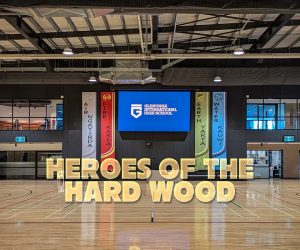



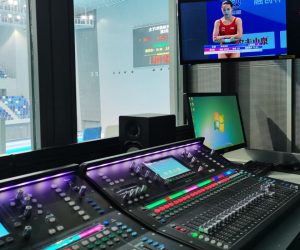
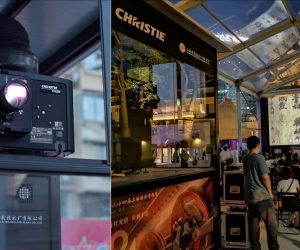




RESPONSES